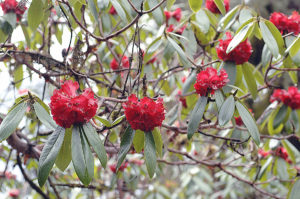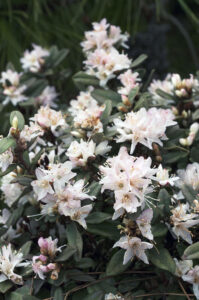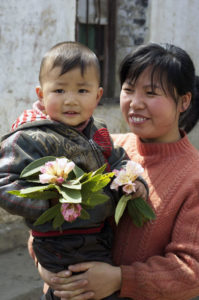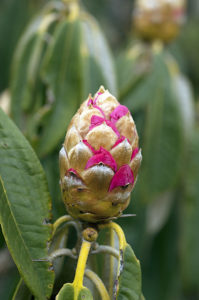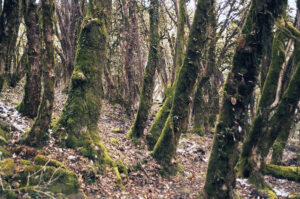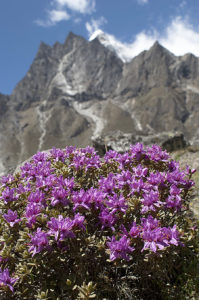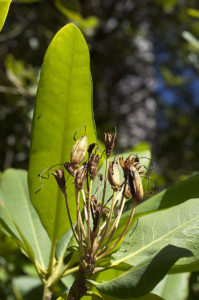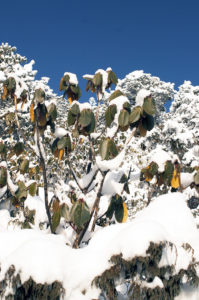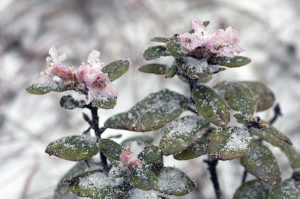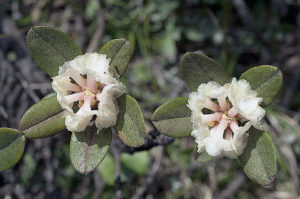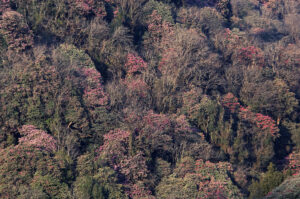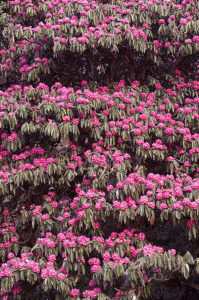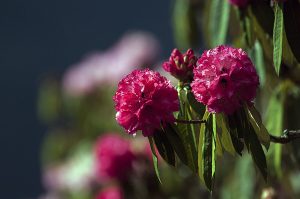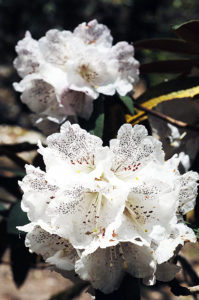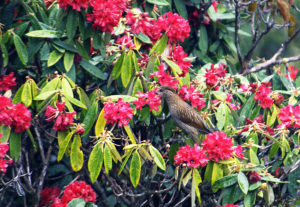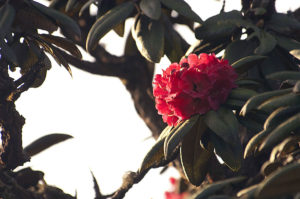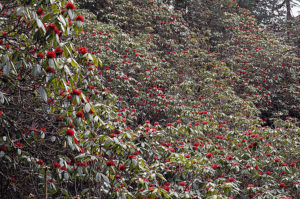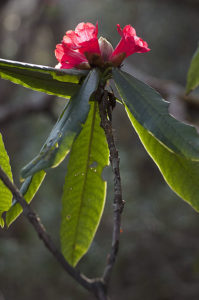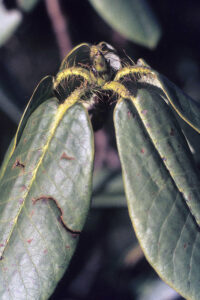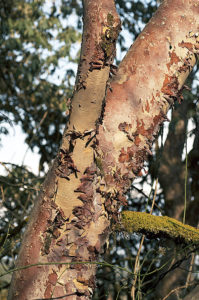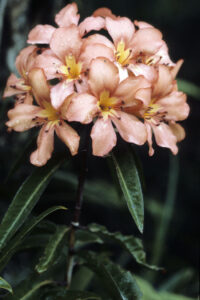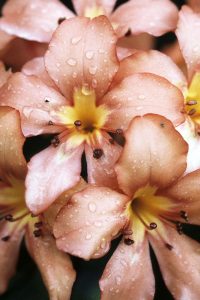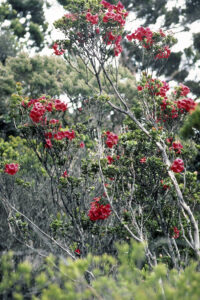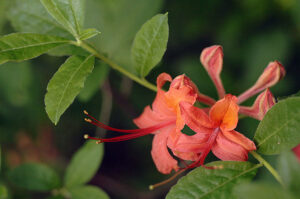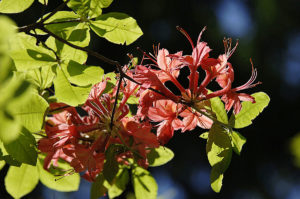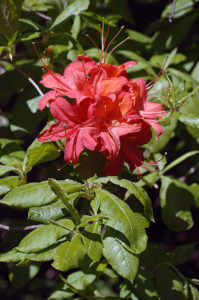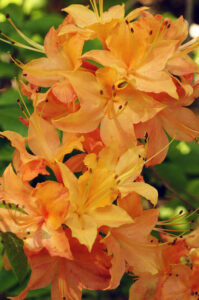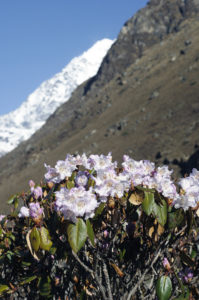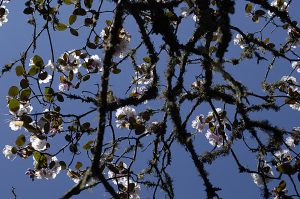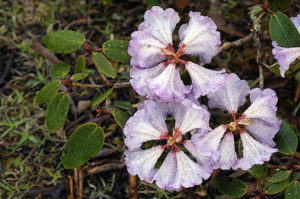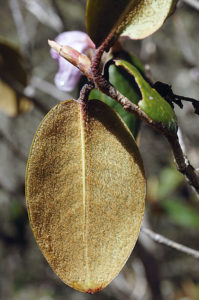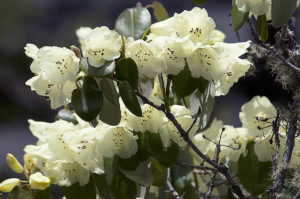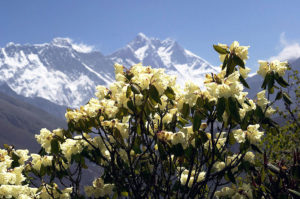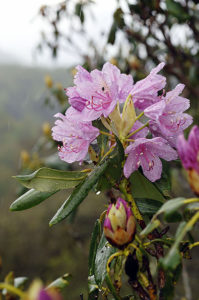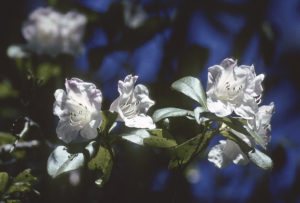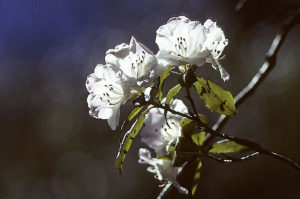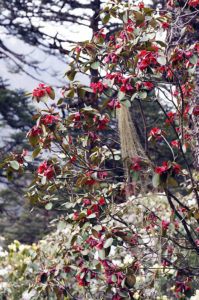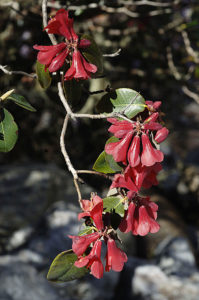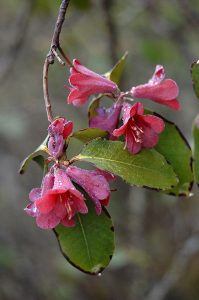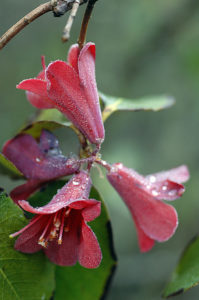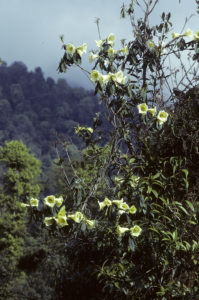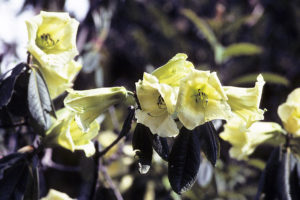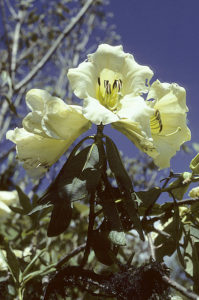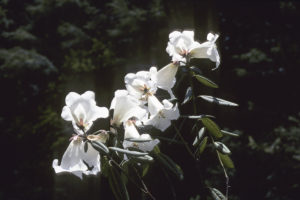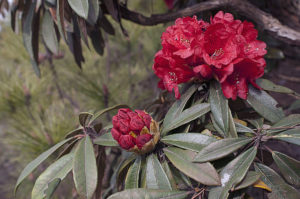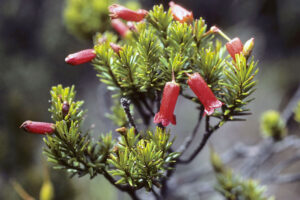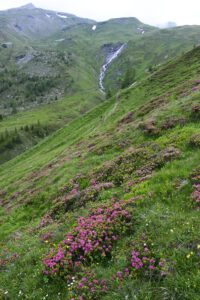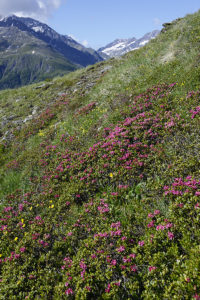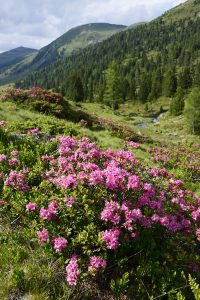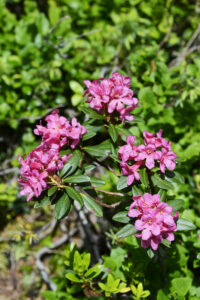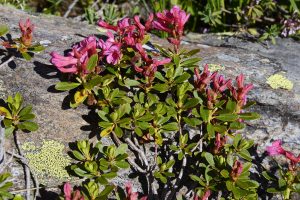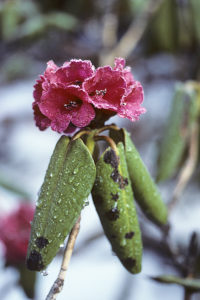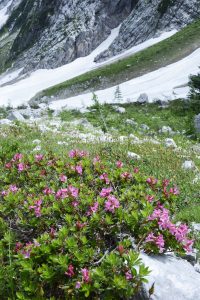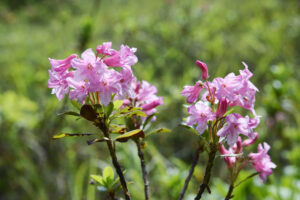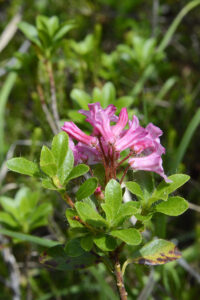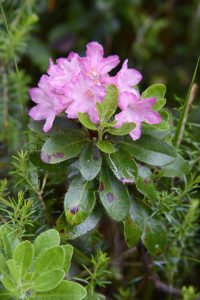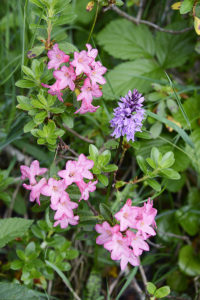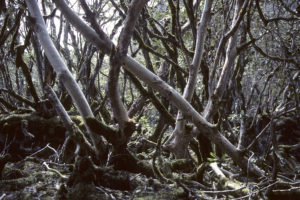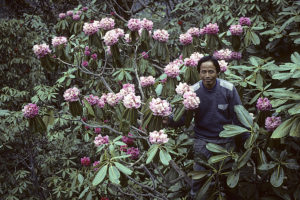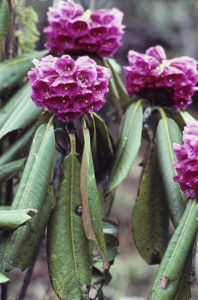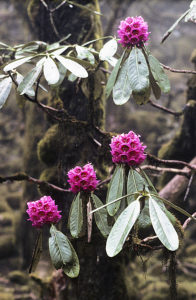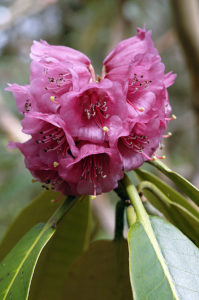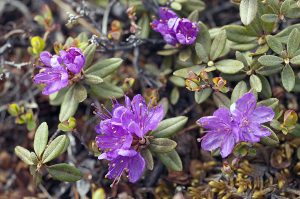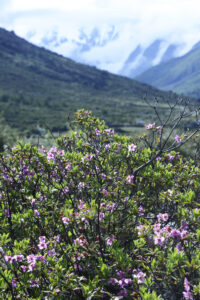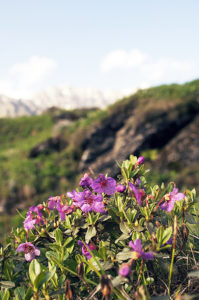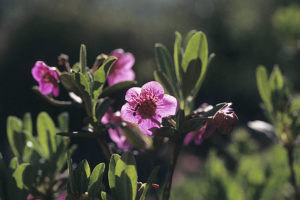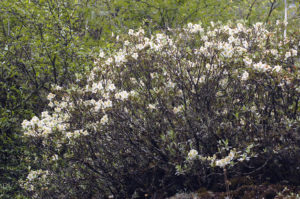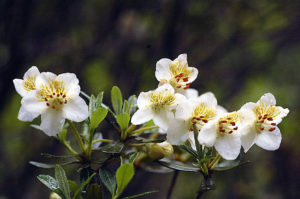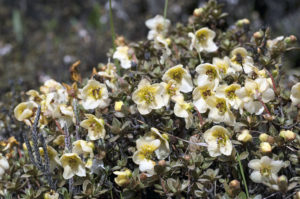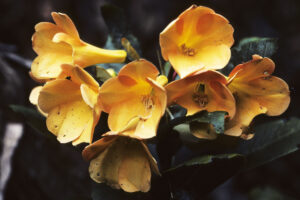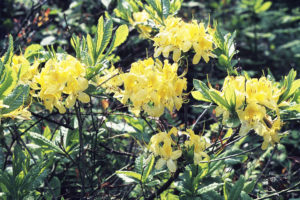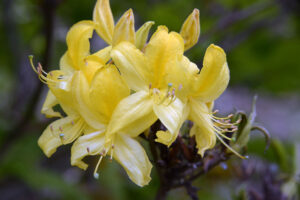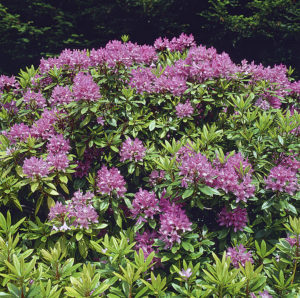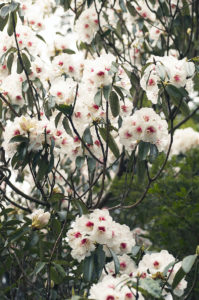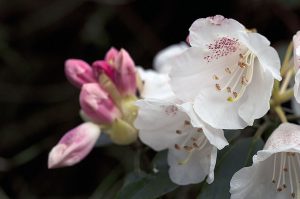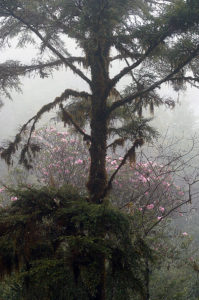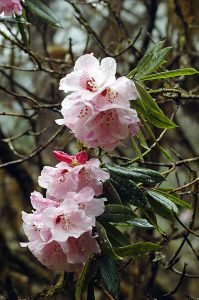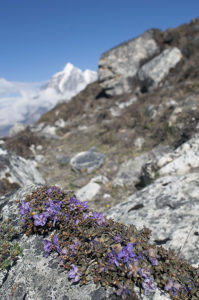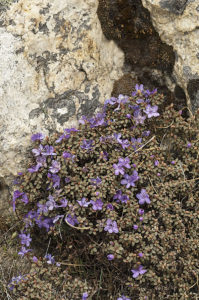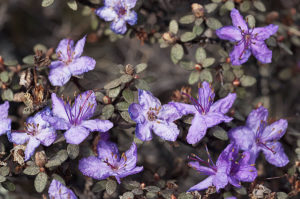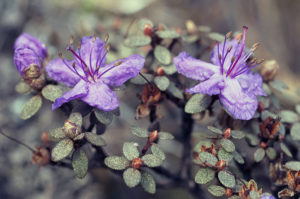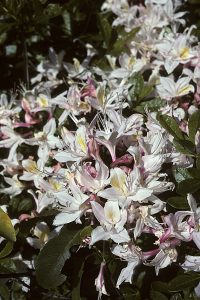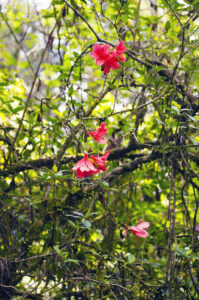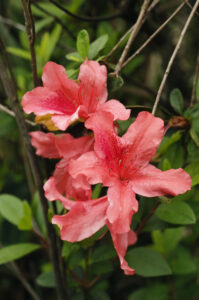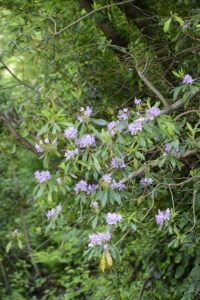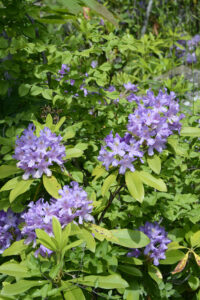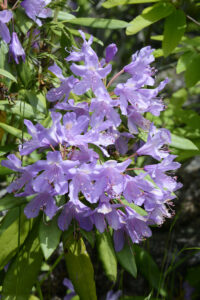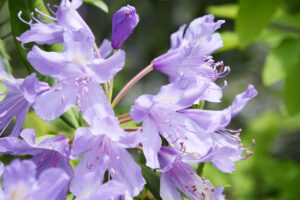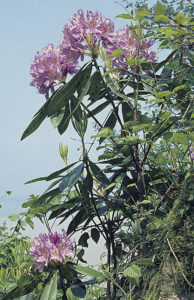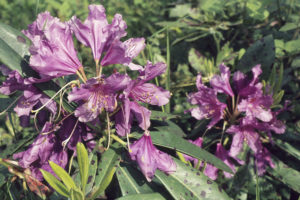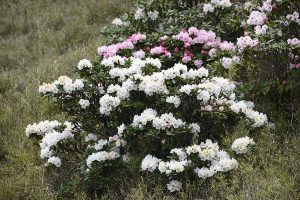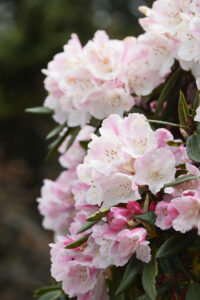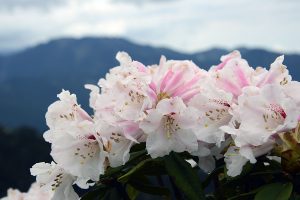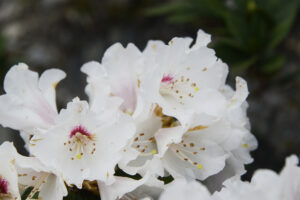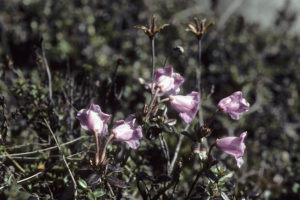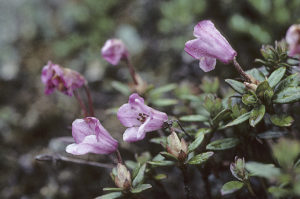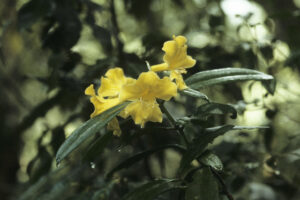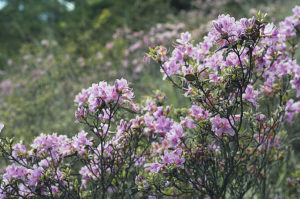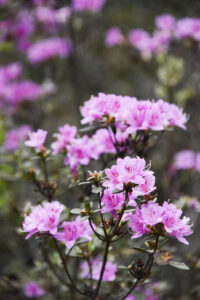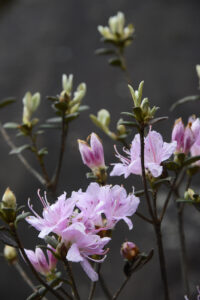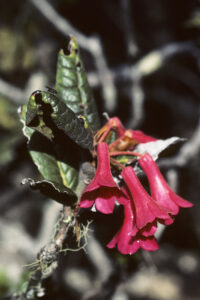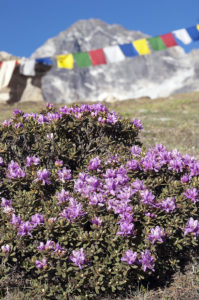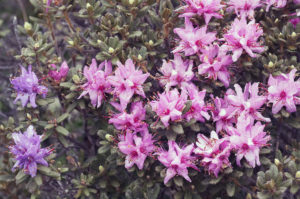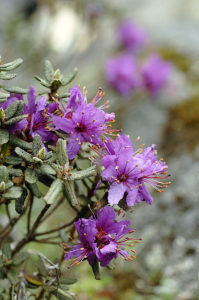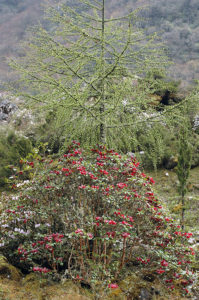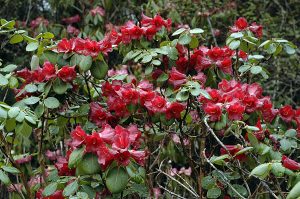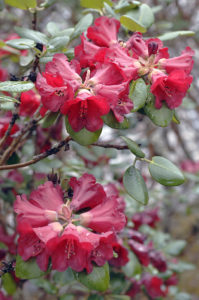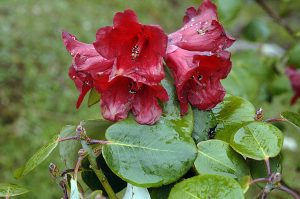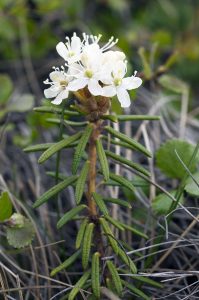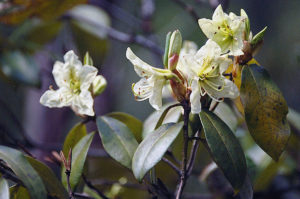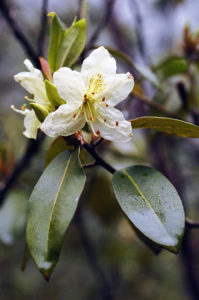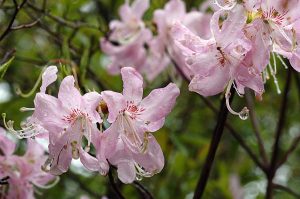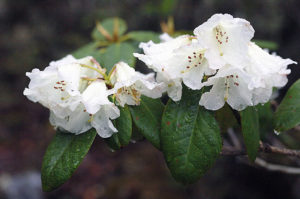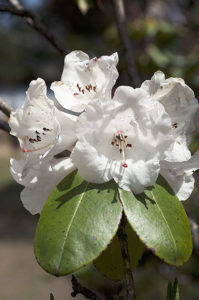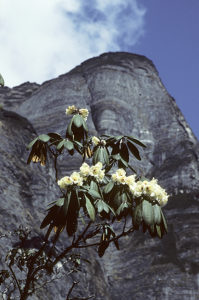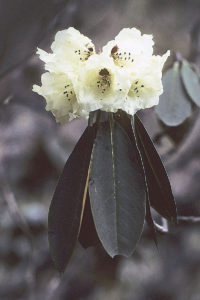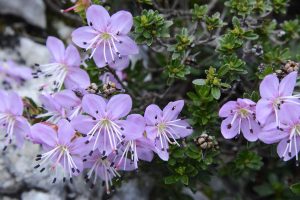Rhododendrons
The word rhododendron is derived from Ancient Greek rhodon (‘rose’) and dendron (‘tree’), thus ‘rose tree’. It seems that to the ancient Greeks, the flowers clusters of certain rhododendron species resembled roses. However, these trees and shrubs are not at all related to roses, but belong to the heath family (Ericaceae). From a distance, though, the flower clusters of some species do resemble roses.
One species, whose flower clusters resemble roses, at least from a distance, is Rhododendron barbatum, here photographed near Tharepati, Langtang National Park, central Nepal. (Photo copyright © by Kaj Halberg)
The genus Rhododendron is huge, comprising about 1,025 species worldwide, found mainly in temperate and subtropical areas of Eurasia, North America, Tropical Asia, and New Guinea, with the largest concentrations in south-western China, the Himalaya, the Greater Sunda Islands, and New Guinea. China is the absolute stronghold of the genus, with no less than c. 571 species, of which 409 are endemic.
The Himalaya is home to about 100 species, the vast majority growing in the eastern part of the mountain chain. A tiny country like Bhutan, for instance, harbours more than 60 species. The further west you travel in the Himalaya, the fewer species you encounter. Eastern Nepal is home to c. 30 species, western Nepal to 7, and Pakistan to only 4.
In tropical regions, the genus is mainly restricted to mountains, but a few species are found in areas with a genuine tropical climate, including one in Queensland, Australia.
Montane areas of Borneo hold c. 55 species of rhododendron, of which about half are restricted to the highest mountains on the island, around Gunung Kinabalu (4094 m). The interesting flora and fauna in this area is described on the page Travel episodes – Borneo 1985: A hike up Gunung Kinabalu.
In North America, 27 rhododendron species are found, with the highest concentration in the eastern part of the continent, mainly in the Appalachian Mountains. Europe, including the Caucasus, is home to 12 species, and a few species are distributed in Arctic areas.
The name Rhododendron is used for evergreen as well as deciduous species, the latter often called azalea. European species are usually called by their German name, Alpenrose (‘rose of the Alps’).
The inflorescence of most species is an umbel-like cluster, corolla funnel- or bell-shaped, with five lobes. The commonest flower colours are various shades of red, pink, or lilac. White and yellow flowers are also frequent, whereas greenish is only seen in a few species.
Previously, species of Labrador tea, or muskeg tea, were placed in a separate genus, Ledum, but genetic analyses have revealed that they are in fact rhododendrons. The names Labrador tea and muskeg tea refer to the usage of the leaves of these plants for tea, and they were also formerly added to beer. Due to their powerful fragrance, they were also utilized to deter moths from clothes.
The descriptions on this page are not very extensive, and for more in-depth descriptions see the following website: data.rbge.org.uk/service/factsheets/Edinburgh_Rhododendron_Monographs
An unidentified rhododendron species, Wumeng Shan Mountains, Guizhou Province, China. (Photo copyright © by Kaj Halberg)
This woman in the Wumeng Shan Mountains has just picked fresh rhododendron flowers and leaves, held by her small son. (Photo copyright © by Kaj Halberg)
Little children in eastern Nepal, one with an armload of Rhododendron arboreum flowers. Cleanliness seems to be of less importance in this area! (Photo copyright © by Kaj Halberg)
This inflorescence of Rhododendron arboreum is still not unfolded, Helambu, central Nepal. (Photo copyright © by Kaj Halberg)
Rhododendrons vary greatly in size, from dwarf shrubs like R. pumilum, R. nivale, and R. lapponicum, which are usually less than 20 cm high, to Himalayan species like R. arboreum and R. grande, which can grow to 15 m tall.
Rhododendron arboreum, a widespread Asian species, can grow to 15 m tall. (Photo copyright © by Kaj Halberg)
Rhododendron setosum is a common dwarf shrub in the Himalaya. It rarely grows taller than 50 cm. This one was photographed in front of a mountain named Taboche (6367 m), Khumbu, eastern Nepal. (Photo copyright © by Kaj Halberg)
The fruit is a capsule, containing between four and twenty chambers. In the pictures below, fruits from the previous year are still sitting on the plant.
Fruit cluster of Rhododendron arboreum, Helambu, Nepal. (Photo copyright © by Kaj Halberg)
Fruit cluster of Pacific rhododendron (Rhododendron macrophyllum), Redwood National Park, California. (Photo copyright © by Kaj Halberg)
Many rhododendron species are very tough, growing under severe climatic conditions.
Rhododendron arboreum forest, Langtang National Park, central Nepal. (Photo copyright © by Kaj Halberg)
Rhododendron campanulatum, Langtang National Park. (Photo copyright © by Kaj Halberg)
Rime-covered flowers and leaves of an unidentified species, Wumeng Shan Mountains, Guizhou Province, China. (Photo copyright © by Kaj Halberg)
Below, the various rhododendrons I have encountered around the world are presented in alphabetical order.
Rhododendron anthopogon
This small, fragrant shrub, to 1 m tall, usually forms dense thickets on open slopes, often covering large areas. Young branches are covered in brown scales. Leaves are elliptic or ovate, to 4 cm long and 2.5 cm wide, base rounded, tip pointed or rounded, upper surface dark green, sparsely scaly, underside covered in overlapping scales, dark reddish-brown or dark yellow-brown, or often both colours. Calyx lobes to 6 mm long, margin densely hairy. The corolla is funnel-shaped, densely hairy in the throat, whitish, yellowish, or pinkish, to 1.2 cm long and 2 cm across, with 5 large, shaggy, almost transparent lobes.
It grows at altitudes between 3,000 and 5,100 m, from Pakistan eastwards to Bhutan and south-eastern Tibet.
In Nepal, where it is called sun pathi, dried flowers are utilized as tea, and the branches are burned as dhup (incense) in temples and on house altars. Vapours from boiled leaves are inhaled to relieve cough and colds.
The specific name derived from Ancient Greek anthos (‘flower’) and pogon (‘beard’), probably alluding to the hairy throat of the flower.
Rhododendron anthopogon, Gokyo Valley, Khumbu, eastern Nepal. (Photo copyright © by Kaj Halberg)
This man from the Gosainkund area of central Nepal shows a tray, full of dried sun pathi flowers. (Photo copyright © by Kaj Halberg)
Rhododendron arboreum
This species, which is among the highest members of the genus, grows to 15 m tall. The bark is reddish or brown. Leaves are oblong or lanceolate, to 20 cm long and 4.5 cm wide, glossy green, underside covered in a dense felt of whitish, fawn-, cinnamon-, or rusty-coloured hairs, veins on upper surface grooved. Flowers bright red, pink, or white, in clusters of 10-20, corolla bell-shaped, to 5 cm long and across, with 5 lobes to 1.7 cm long.
It is very common in the Himalaya, and in March-April, when it is flowering, it adds a reddish or pinkish tinge to the forest in numerous places, stemming from millions of flowers. The intensity of the red flower colour decreases with altitude, and near the upper limit of its distribution, around 3,800 m, you sometimes encounter trees with white flowers.
In Nepal, this tree is the national plant, called lali guras (‘red rhododendron’), and the flowers are brought as offerings in Hindu and Buddhist shrines. The petals are edible, utilized for sore throat and cough, and also pickled. Juice of the bark is taken for diarrhoea, dysentery, and cough, a paste of the leaves for headache, juice of the flowers for menstrual problems and dysentery. Juice of the leaves is spread on beds to get rid of vermin, and young leaves are used to stupefy fish in streams. The wood is utilized for making furniture, fences, and charcoal, and as fuel, and dried leaves serve as compost.
In its widest sense, this species has an extensive distribution in Asia, from Pakistan eastwards to montane areas of northern Thailand and Vietnam, with isolated subspecies in mountains of South India, the Nilgiri rhododendron, ssp. nilagiricum, and in Sri Lanka, ssp. zeylanicum. These subspecies are regarded as separate species by some authorities.
The specific name is Latin, meaning ‘tree-like’, alluding to the large size of this species.
When flowering, Rhododendron arboreum adds a reddish or pinkish tinge to large tracts of forest, here in the Annapurna area, central Nepal. (Photos copyright © by Kaj Halberg)
Various flower colours of Rhododendron arboreum. (Photos copyright © by Kaj Halberg)
In spring, the flowers of Rhododendron arboreum produce a profusion of pollen. For this reason, they are much visited by various bird species, in this picture a striated laughing-thrush (Grammatoptila striata). – Annapurna, central Nepal. (Photo copyright © by Kaj Halberg)
Nilgiri rhododendron, ssp. nilagiricum, photographed in the Nilgiri Mountains, Tamil Nadu. (Photo copyright © by Kaj Halberg)
Rhododendron barbatum
From a distance, this species, growing to 6 m tall, is quite similar to R. arboreum (above), but a closer look reveals distinctive glandular bristles on twigs and leaf-stalk, and the bark is peeling off in thin, cinnamon-coloured or greyish flakes. The crimson flowers are clustered in dense umbels, to 13 cm across, the bell-shaped corolla to 3.6 cm long, with 5 blackish-red nectar pouches at the base.
It is very common in the Himalaya, found from Uttarakhand eastwards to Bhutan and south-eastern Tibet, often forming pure stands at altitudes between 2,400 and 3,600 m.
The specific name is Latin, meaning ‘bearded’, alluding to the bristles on twigs and leaf-stalk.
Rhododendron barbatum often forms pure stands, as in this picture from Kutumsang, Langtang National Park, central Nepal. (Photo copyright © by Kaj Halberg)
Rhododendron barbatum, Ghorepani, Annapurna, central Nepal. Note the pale green, unfelted underside of the leaves. (Photo copyright © by Kaj Halberg)
This picture from Helambu, central Nepal, shows the distinctive bristles on the leaf-stalks of Rhododendron barbatum. (Photo copyright © by Kaj Halberg)
The bark of Rhododendron barbatum peels off in thin, cinnamon-coloured flakes. (Photo copyright © by Kaj Halberg)
Rhododendron brookeanum
This species may be either epiphytic or terrestrial, usually only about 2 m tall, leaves to 30 cm long and 9 cm wide. The flowers come in many colours, pale yellow, orange, red, or flesh-coloured, often with a yellow throat. It is widespread in Borneo and northern and western Sumatra, growing from sea level to altitudes around 1,500 m.
It was named in honour of Sir James Brooke (1803-1868), a British soldier and adventurer, who helped the Sultan of Brunei to suppress a revolt, and as a reward became governor of Sarawak, titled Rajah Brooke, from 1841 until his death in 1868.
Many authorities regard this plant as a subspecies of the widespread R. javanicum.
Flesh-coloured form of Rhododendron brookeanum. It is quite common in the forests of Mount Kinabalu, where these pictures were taken. (Photos copyright © by Kaj Halberg)
Rhododendron buxifolium
A large shrub or a tree, to 10 m tall, leaves small, broadly elliptic or almost circular, to 3.7 cm long and 2.8 cm broad, but often much smaller, which is reflected in the specific name, meaning ‘with leaves like Buxus’ (box).
This beautiful species is common on Mount Kinabalu, Sabah, Borneo, but is not found anywhere else. It grows at elevations between 3,100 and 3,900 m.
Rhododendron buxifolium, Gunung Kinabalu, Sabah, Borneo. (Photos copyright © by Kaj Halberg)
Rhododendron calendulaceum Flame azalea
This plant is distributed in eastern United States, mainly in the Appalachian Mountains, from West Virginia southwards to Georgia and Alabama, with isolated populations in Ohio and Kentucky. Due to its gorgeous flowers, it is widely cultivated elsewhere, and naturalized plants may be observed as far north as New York and Massachusetts.
It is a shrub or small tree, sometimes growing to 10 m tall, leaves ovate or elliptic, to 8 cm long and 3 cm wide, the colour of the corolla varying from orange to bright red, hence its common name.
The specific name means ‘coloured like Calendula‘, referring to marigold (Calendula officinalis), which often has bright orange flowers.
Flame azalea, Cades Cove, Great Smoky Mountains National Park, Tennessee. (Photo copyright © by Kaj Halberg)
These flame azalea in Maudsley State Park, Massachusetts, are escapes from earlier cultivation. (Photos copyright © by Kaj Halberg)
Rhododendron campanulatum
As its specific name, derived from the Latin campanula (‘little bell’), implies, this attractive shrub, to 6 m tall, has broadly bell-shaped flowers, clustered in umbels with up to 12 flowers, corolla mauve, rose-coloured, lilac, or purple, rarely white, to 4 cm long, with 5 rounded lobes. Leaves are leathery, broadly elliptic or ovate, to 15 cm long and 6 cm wide, tip rounded, with a rusty-coloured layer of hairs below.
This plant is very common from Pakistan eastwards to Bhutan and south-eastern Tibet, often forming dense thickets at altitudes between 2,800 and 4,300 m.
In Nepal, the wood is collected for fuel, and juice of the leaves is used for rheumatism and syphilis.
Rhododendron campanulatum, Kyanjin Gompa, Langtang National Park, central Nepal. The mountain in the background is Langtang II (7227 m). (Photo copyright © by Kaj Halberg)
Rhododendron campanulatum, Ghunsa Valley, eastern Nepal. In the lower picture, numerous rain drops cling to the flowers. (Photos copyright © by Kaj Halberg)
One characteristic of Rhododendron campanulatum is the egg-shaped leaves with a rusty-coloured layer of hairs on the underside. – Ghunsa Valley. (Photo copyright © by Kaj Halberg)
Rhododendron campylocarpum
This shrub, to 3 m tall, is very common from eastern Nepal eastwards to south-western China, at altitudes between 3,000 and 4,000 m. In places, it brightens large tracts of forest with its beautiful pale yellow inflorescences.
The leaves are dark green, shining on the upperside, greenish below, rounded or elliptic, to 8.5 cm long and 4 cm wide, margin slightly recurved, tip rounded. Flowers are in terminal umbels, up to 7 together, bell-shaped, pale yellow, to 4 cm long and across, with 5 lobes to 2 cm long.
The specific name is derived from Ancient Greek kampylos (‘curved’) and karpos (‘fruit’), alluding to the curved capsules of this plant.
Rhododendron campylocarpum is very common in the Khumbu area, eastern Nepal, where these pictures were taken. (Photos copyright © by Kaj Halberg)
Rhododendron campylocarpum, photographed near the Buddhist monastery Tengboche, Khumbu. The peaks of Nuptse (7879 m, at left), Sagarmatha (Everest) (8850 m, behind Nuptse), and Lhotse (8511 m, centre) are seen in the background. (Photo copyright © by Kaj Halberg)
Rhododendron catawbiense Catawba rhododendron
This shrub, growing to 3 m tall, has alternate, elliptic or oblong leaves, to 11 cm long and 5 cm wide, base and tip rounded, inflorescences dense, with 15-20 flowers, corolla funnel- or bell-shaped, to 4.5 cm long, pink or pale purple with green or yellowish-brown dots on the inside of the upper lobe.
It is native to the eastern United States, from Maryland and Kentucky southwards to Alabama and Georgia, forming dense thickets on rocky slopes in the Appalachian Mountains, from the lowlands to elevations around 1,000 m, especially in North Carolina and Virginia.
The specific name refers to the Catawba River, which originates in western North Carolina, flowing into South Carolina.
Catawba rhododendron with raindrops, Pisgah National Forest, North Carolina. (Photo copyright © by Kaj Halberg)
Rhododendron ciliatum
A small shrub to 2 m tall, often growing on rocks. Leaves are leathery, elliptic or oblong, to 9 cm long and 3.7 cm wide, with bristly margin, and along the midrib, scaly below. Flowers are in small terminal clusters, 2-4 together, corolla funnel-shaped, to 5 cm long, white, often tinged with pink, with 5 notched, overlapping lobes, flower-stalks bristly.
This plant has a rather limited distribution, found from eastern Nepal eastwards to Bhutan and south-eastern Tibet, growing at altitudes between 2,700 and 3,900 m.
The specific name is Latin, meaning ‘hairy’, alluding to the bristly leaf margin and flower-stalk.
Rhododendron ciliatum, Barun Valley, eastern Nepal. (Photo copyright © by Kaj Halberg)
Rhododendron cinnabarinum
This shrub, to 4 m tall, can be identified by its tubular, waxy, fleshy, often pendent flowers, to 5 cm long, which are usually crimson, but sometimes pinkish, yellow, or purplish, with 5 rather upright lobes, to 1.7 cm long. Leaves are leathery, elliptic, oblong, or ovate, to 10 cm long and 5 cm broad, bluish-green and scaly below.
It grows at altitudes between 3,000 and 4,000 m, from eastern Nepal eastwards to Myanmar and the Yunnan Province in China.
In Nepal, the wood is collected for fuel.
The specific name is derived from Ancient Greek kinnabaris, indicating a bright red colour, tinted with orange. The name of course alludes to the flower colour.
Rhododendron cinnabarinum is common in the Upper Ghunsa Valley, eastern Nepal, where this picture was taken. Its branches are draped with old-man’s-beard lichens (Usnea). (Photo copyright © by Kaj Halberg)
The most common flower colour of Rhododendron cinnabarinum is dark red. – Ghunsa Valley. (Photo copyright © by Kaj Halberg)
Occasionally, paler flowers with a purplish sheen may be observed. – Ghunsa Valley. (Photos copyright © by Kaj Halberg)
Rhododendron columbianum Western Labrador tea, trapper’s tea
An erect shrub to 2 m tall, bark smooth, sometimes peeling, leaves evergreen, leathery, ovate or lanceolate, to 8 cm long and 3 cm wide, dark green above, whitish and smooth beneath with minute scales, fragrant when crushed. The inflorescence is a terminal cluster, to 5 cm across, with 10-35 bell-shaped flowers, corolla to 1.5 cm across, white or cream-coloured, petals obovate, spreading.
This plant is distributed in western North America, from British Columbia southwards to California, eastwards to Alberta, Montana, Wyoming, Utah, and Colorado. It is partial to wet places, from sea level up to altitudes around 3,600 m.
It was first collected by Scottish gardener and botanist David Douglas (1799-1834), who explored the North American flora during three expeditions. He died under mysterious circumstances while climbing Mauna Kea in Hawaii in 1834. Apparently, he fell into a pit trap and was possibly crushed by a bull that fell into the same trap. He was last seen at the hut of Englishman Edward ‘Ned’ Gurney, a bullock hunter and escaped convict. Gurney was suspected of causing Douglas’s death, as Douglas was said to have been carrying more money than Gurney subsequently delivered with the body. (Source: Nisbet, J. 2009. The Collector: David Douglas and the Natural History of the Northwest. Sasquatch Books)
Previously, this plant was named R. neoglandulosum, and prior to that Ledum columbianum. As its popular names imply, tea was formerly brewed on the leaves.
It is easily distinguished from R. tomentosum (below) by its smooth stems and leaves.
Western Labrador tea, encountered in Kruse State Forest, California. (Photo copyright © by Kaj Halberg)
Rhododendron dalhousiae
In April-May, this epiphytic species, to 2 m long, displays a profusion of large, fragrant, yellow or lemon-coloured flowers, which later turn white. Corolla is to 10 cm long and wide, with 5 large recurved lobes. Young shoots are bristly-scaly. Leaves are oblong or oblanceolate, to 15 cm long and 5 cm wide, with grooved veins on the upper side, underside bluish-green and scaly.
It is distributed from central Nepal eastwards to Arunachal Pradesh and south-eastern Tibet, and it is also found in Bangladesh. In the Himalaya, it grows at elevations between 1,500 and 2,600 m.
It is cultivated elsewhere as an ornamental, and is threatened by excessive collecting. In Nepal, juice of young leaves is applied to wounds on cattle.
This gorgeous plant was named by British botanist Joseph Dalton Hooker (see below) in honour of Lady Dalhousie, wife of George Ramsay, the 9th Earl of Dalhousie, who was governor-general in India in the first half of the 1800s. Lady Dalhousie was an avid collector of plants.
Rhododendron lindleyi is similar, but the calyx is fringed with soft white hairs.
Rhododendron dalhousiae, Tashigaon, Arun Valley, eastern Nepal. (Photos copyright © by Kaj Halberg)
On this specimen of Rhododendron dalhousiae, the flower colour has changed to snow-white, Gyapla, Ghunsa Valley, eastern Nepal. (Photo copyright © by Kaj Halberg)
Joseph Dalton Hooker
Joseph Dalton Hooker (1817-1911) was a British botanist, one of the founders of geographical botany. He participated in several botanical expeditions, to Antarctica 1839-1843, to the Himalaya and India 1847-1851, to Palestine 1860, to Morocco 1871, and to the western United States 1877.
In 1865, he was appointed Director of the Royal Botanic Gardens, Kew, holding the post for twenty years. He was a close friend of the famous Charles Darwin (1809-1882).
During his stay in Asia, he described no less than 22 new rhododendron species from Sikkim and other parts of the eastern Himalaya.
Joseph Dalton Hooker was one of the most eminent botanists of the 19th Century. (Photo: Public domain)
Rhododendron delavayi
This magnificent plant is distributed in south-western China, south-eastern Tibet, Bhutan, Arunachal Pradesh in north-eastern India, and in mountains of northern Myanmar, Thailand, and Vietnam. It grows in various types of forests, at elevations between 1,500 and 3,000 m.
It is quite similar to R. arboreum (above), and some authorities regard it as a subspecies of that species. Leaves to 14 cm long and 2.5 cm wide, tip sharply pointed, underside covered in whitish or brownish hairs. Corolla usually deep crimson or carmine.
The specific name was given in honour of French missionary, explorer, and botanist Père Jean-Marie Delavay (1834-1895), who was an avid plant collector, sending over 200,000 herbarium specimens back to France, from which numerous new genera and over 1,500 new species were described.
Rhododendron delavayi, Wumeng Shan Mountains, Guizhou Province, China. (Photo copyright © by Kaj Halberg)
Rhododendron ericoides
This erect shrub, to 1.5 m tall, is restricted to higher altitudes on Gunung Kinabalu, Borneo, between 2,700 and 4,000 m. At higher elevations, it is often stunted and low.
It is easily identified by the small, red, tubular flowers and the tiny leaves, which are reminiscent of those of crowberry (Empetrum nigrum).
The specific name is Latin, meaning ‘resembling Erica‘ (heather), referring to the leaves.
Rhododendron ericoides, Gunung Kinabalu, Borneo. (Photo copyright © by Kaj Halberg)
Rhododendron ferrugineum Rusty-leaved alpenrose
This small shrub is the commonest European rhododendron species, distributed in the Pyrenees, the Alps, the Jura Mountains, and the northern part of the Apennines. It often covers large areas of mountain slopes at elevations between 1,600 and 2,200 m, especially on acid soils.
It grows to 1.5 m tall, young shoots covered in rust-coloured scales, leaves oblong or ovate, tapering at both ends, to 4 cm long and 1.4 cm wide, dark glossy green and slightly scaly above, underside covered with golden-brown, later rust-coloured scales. Inflorescences are terminal clusters of 6-12 funnel-shaped, short-stalked flowers, to 2 cm long and across, corolla rose-coloured or scarlet, scaly outside, with 5 spreading, oblong lobes.
This plant was cultivated in Britain as early as 1740.
The specific name is derived from the Latin ferrugineum (‘rust-coloured’), derived from ferrum (‘iron’), alluding to the rusty scales on the underside of the leaves. The common name is adapted from the German Alpenrose (‘rose of the Alps’).
Rusty-leaved alpenrose, covering a mountain slope near Kasereck, Grossglockner, Austria. (Photos copyright © by Kaj Halberg)
Rusty-leaved alpenrose, Rosanin Valley, nær Thoma Valley, Austria. (Photo copyright © by Kaj Halberg)
Rusty-leaved alpenrose, Sölkpass, Austria. (Photo copyright © by Kaj Halberg)
Rusty-leaved alpenrose, Grossglockner. The plant in the background is striped daphne (Daphne striata). (Photo copyright © by Kaj Halberg)
Rhododendron fulgens
This shrub, to 4 m tall, has a rather limited distribution, found from eastern Nepal eastwards to Bhutan and south-eastern Tibet, growing at altitudes between 3,300 and 4,500 m. Leaves are leathery, oblong or broadly ovate, to 11 cm long and 7 cm wide, base rounded or heart-shaped, tip rounded, glossy-green above, covered in reddish-brown felt below. Flowers are blood-red, bell-shaped or tubular, to 4 cm long and across, with 5 dark nectar pouches in the throat. Anthers are chocolate-brown.
In Nepal, the wood is used as fuel.
The specific name is Latin, meaning ‘shining’, probably alluding to the glossy leaves.
Early in the morning, the flowers of this Rhododendron fulgens, growing in the Barun Valley, eastern Nepal, are covered in rime. (Photo copyright © by Kaj Halberg)
Rhododendron hirsutum Hairy alpenrose
This species closely resembles the rusty-leaved alpenrose (above), but differs by its ciliate leaf margins and the pale pink flowers. It is common on carbonate-rich soils in the Alps, from Switzerland eastwards, and in the Carpathians, where it may be introduced. Occasionally, the two species grow in the same area, in which case they often hybridize.
The specific name is Latin, meaning ‘hairy’, alluding to the ciliate leaf margin. The common name is adapted from the German Alpenrose (‘rose of the Alps’).
Hairy alpenrose, Vrata Valley, Triglavski National Park, Slovenia. (Photos copyright © by Kaj Halberg)
Hairy alpenrose, Prehodavci, near Trenta Valley, Triglavski National Park. (Photo copyright © by Kaj Halberg)
Close-up of hairy alpenrose, showing the ciliate leaves, Kandersteg, Berner Oberland, Switzerland. (Photo copyright © by Kaj Halberg)
Hairy alpenrose, Berner Oberland. A common spotted orchid (Dactylorhiza maculata ssp. fuchsii) is also present. (Photo copyright © by Kaj Halberg)
Rhododendron hodgsonii
This large shrub, which grows to 7 m tall, is easily identified by its dense, flat-topped inflorescences and large leaves. It has a rather limited distribution, from eastern Nepal eastwards to Arunachal Pradesh and south-eastern Tibet, often forming pure stands at altitudes between 3,000 and 4,000 m.
The leaves are leathery, oblong, elliptic, or oblanceolate, to 30 cm long and 12 cm wide, dark green above, woolly-haired beneath, base and apex rounded, leaf-stalk thick. Flowers are in very dense, flat-topped clusters, 15-20-flowered, corolla tubular or bell-shaped, magenta, purple, pink, pale pink, or whitish, to 4 cm long and 5 cm across, with 7-8 small lobes and darker basal blotches in the throat.
In Nepal, the wood is used as fuel.
The specific name was applied by Joseph Dalton Hooker (see R. dalhousiae above) in honour of his friend, British naturalist and ethnologist Brian Houghton Hodgson (1801-1894), who described numerous new species of birds and mammals in the Himalaya.
Dense forest of Rhododendron hodgsonii, Lower Barun Valley, Makalu-Barun National Park, eastern Nepal. (Photo copyright © by Kaj Halberg)
The flower colour of Rhododendron hodgsonii varies from magenta to whitish. Here, my guide Saila Tamang is standing in a dense growth in the Barun Valley. (Photo copyright © by Kaj Halberg)
Rhododendron hodgsonii, Barun Valley. (Photo copyright © by Kaj Halberg)
Rhododendron hodgsonii, Ghunsa Valley, eastern Nepal. (Photos copyright © by Kaj Halberg)
Rhododendron kochii
A shrub or small tree, to 10 m tall, leaves 4-8 together in dense pseudo-whorls, blade elliptic or obovate, to 16 cm long and 5 cm wide, inflorescences with 10-20 flowers in an open umbel, corolla to 5 cm long and across, funnel-shaped, white.
This species is restricted to the Philippines, growing in humid forests at elevations between 1,000 and 2,300 m.
It was named after German zoologist Otto Koch, who collected plants and animals in the Philippines.
Rhododendron kochii, Sagada, Luzon, Philippines. (Photo copyright © by Kaj Halberg)
Rhododendron lapponicum Lapland rhododendron
This dwarf shrub, also known as Lapland rosebay, is distributed in subarctic regions of the Northern Hemisphere. It comes in two varieties, lapponicum of Eurasia, and parvifolium in eastern Siberia and North America.
It is a much-branched, prostrate or erect shrub, to 1 m tall, leaves to 2 cm long and 9 mm wide, oblong, elliptic, or ovate, tip rounded, base narrowly triangular, underside fawn or ferrugineous, scaly. Inflorescence short-stalked, with 3-6 flowers, calyx tiny, corolla broadly funnel-shaped, rose-coloured, violet, or purple, occasionally white, to 1.4 cm long.
Martin Henrichsen Vahl (1749-1804) was a Danish-Norwegian naturalist, who studied botany at the University of Copenhagen, and also at Uppsala University under the famous Carl Linnaeus. Vahl was a lecturer at the University of Copenhagen Botanical Garden 1779-1782, and was the editor of several botanical works, including Flora Danica, Vol. XVI-XXI, Symbolæ Botanicæ, Vol. I-III, Eclogæ Americanæ, Vol. I-IV, and Enumeratio Plantarum, Vol. I-II.
In 1787, Vahl travelled to Norway in search of plants to be illustrated in Flora Danica. (Norway was then a Danish territory.) From Copenhagen, he went by ship to Christiania (Oslo), then north through the Gudbrand Valley and further on to the town of Lom, situated at the foot of the highest peaks of Norway, in Jotunheimen and Dovre. In 1792, Vahl wrote enthusiastically about a botanical trip near the town: “One of the rarest Norwegian plants, Azalea lapponica, was ample reward for struggling towards the peak of a high mountain, through snow and morass. The pleasure of having seen this plant alive was further increased by the fact that it might easily have escaped my attention, as only two bushes were growing here.” (Source: H. Knudsen 2014. Fortællingen om Flora Danica. Lindhardt & Ringhof, in Danish)
The specific name is Latin, meaning ‘found in Lapland’.
Lapland rhododendron, var. parvifolium, Chukotka Peninsula, eastern Siberia. (Photo copyright © by Kaj Halberg)
Rhododendron lepidotum
Flowers of this dwarf shrub, to 1.5 m tall, vary in colour, from red or purple to pink or white. Occasionally, a form with pale yellow flowers may also be observed. They are axillary, long-stalked, broadly bell-shaped, to 1.7 cm long and 2.5 cm across, often terminal, solitary or up to 4 together. The leaf shape also varies quite a lot, obovate, elliptic, oblong, or lanceolate, to 3.8 cm long and 1.8 cm wide, scaly on both surfaces, tip rounded or pointed, sometimes with a short spine.
This is one of the most widespread and common Himalayan rhododendron species, distributed from Pakistan eastwards to south-western China. It also has a wide altitudinal range, found between 2,000 and 4,700 m.
In Nepal, dried leaves are burned as dhup (incense) in temples. Tea made from the leaves is taken as a blood purifier. Pounded leaves are spread on beds to get rid of vermin.
The specific name is derived from Ancient Greek lepís (‘scale’), alluding to the abundance of scales on both sides of the leaves.
Shrubs of red-flowered Rhododendron lepidotum, Mundo, Upper Langtang Valley, central Nepal (top), and Ghumtarao, Great Himalayan National Park, Himachal Pradesh. (Photos copyright © by Kaj Halberg)
Red-flowered form, Langtang National Park, central Nepal. Note the ant in the flower. (Photo copyright © by Kaj Halberg)
White-flowered form, Ghunsa Valley, eastern Nepal. (Photos copyright © by Kaj Halberg)
The rare yellowish form, observed in the Gokyo Valley, Khumbu, eastern Nepal. (Photo copyright © by Kaj Halberg)
Rhododendron lowii
This shrub or small tree, to 10 m tall, has spirally arranged, stalked leaves along the stem, ovate or elliptic, to 20 cm long and 10 cm wide, tip blunt, margin entire, often slightly wavy, base rounded or heart-shaped, almost smooth above, scaly below, lateral veins 9-15 on both sides of the mid-rib. Flowers long-stalked, corolla funnel-shaped, yellow or orange, or a combination, sometimes flushed with pink, tube to 3.5 cm long, straight, lobes broadly obovate, spreading, to 5 cm long and wide.
It is endemic to the province of Sabah, Borneo, where it grows on Mount Kinabalu and a few other places, at elevations between 2,700 and 3,650 m.
It was named in honour of British naturalist Hugh Low (1824-1905), who was also colonial administrator of the Malay Peninsula. He made the first documented ascent of Mount Kinabalu in 1851, and the highest peak is named after him.
Rhododendron lowii, Gunung Kinabalu, Sabah, Borneo. (Photo copyright © by Kaj Halberg)
Rhododendron luteum Yellow azalea
A deciduous shrub, to 4 m tall, stem glandular. Leaves almost sessile, ovate or oblanceolate, to 8.5 cm long and 2.5 cm wide, often glandular-hairy. Inflorescences in terminal or axillary clusters with 5-15 short-stalked flowers, corolla pale yellow or golden, to 4.5 cm across, glandular-hairy on the underside, tube to about 1.5 cm long, lobes to 2 cm.
Yellow azalea is distributed from Poland southwards through Austria to the Balkans, and thence eastwards to the Caucasus. It grows in forests and on grassy slopes, from sea level to elevations around 2,000 m.
Its sweet-smelling flowers attract bees, but the honey produced from them is actually toxic, and reports of people being poisoned by consuming this honey date as far back as Ancient Greece.
Yellow azalea, photographed on the Turkish Black Sea coast, near the town of Tirebolu. (Photo copyright © by Kaj Halberg)
Yellow azalea, Dikmen Dağlari, south of Inebolu, Turkey. (Photo copyright © by Kaj Halberg)
Rhododendron macrophyllum Pacific rhododendron
As its name implies, this species is distributed along the North American Pacific Coast, from Monterey Bay in California northwards to British Columbia. It is mainly coastal, but is also found rather far inland in the Cascade Mountains of Oregon, Washington, and British Columbia, up to elevations around 1900 m.
It is a large evergreen shrub or a small tree, to 9 m tall, leaves thick, leathery, broadly elliptic, to 23 cm long and 7.5 cm wide, tip pointed, base narrowly triangular, both surfaces smooth. Inflorescences are terminal pyramidal clusters of 10-20 stalked flowers, calyx tiny, corolla broadly bell-shaped, to 4 cm long, pink or white with yellowish or brownish dots.
The specific name is derived from Ancient Greel makros (‘long’) and phyllon (‘leaf’), thus ‘long-leaved’.
Pacific rhododendron, near Trinidad, California. (Photos copyright © by Kaj Halberg)
Rhododendron morii
This species is endemic to mountains of central and eastern Taiwan, growing in forests, mainly at elevations between 2,000 and 2,200 m.
A shrub or small tree, to 8 m tall, leaves short-stalked, lanceolate or elliptic, to 14 cm long and 3.5 cm broad, tip pointed, base rounded, smooth above, hairy along the midrib below. Inflorescences are dense or lax terminal clusters of 5-12 flowers, calyx tiny, corolla broadly bell-shaped, white or pink, with many red dots and usually a red blotch near the throat.
It was named in honour of Japanese anthropologist and naturalist Ushinosuke Mori (1877-1926), who went to Taiwan as an army interpreter and began to conduct research in fields of anthropology, history, folklore, archaeology, botany, and geography, his main interest being Taiwan aboriginals. In 1926, he disappeared while on board the steamship Kasadomaru. According to the authorities, he committed suicide by jumping into the sea.
Previously, this plant was regarded as a subspecies of R. pseudochrysanthum (below). It differs by being larger, with larger leaves.
White-flowered form of Rhododendron morii, Hohuan Shan, central Taiwan. (Photos copyright © by Kaj Halberg)
Pinkish form of Rhododendron morii, photographed on a foggy day in montane forest, Taipingshan National Forest, eastern Taiwan. (Photos copyright © by Kaj Halberg)
Rhododendron nivale
The alpine zone of the Himalaya, above the tree limit, is home to several species of dwarf rhododendron, including this plant, which is distributed from western Nepal eastwards to south-western China, at altitudes between 4,500 and 5,600 m, mainly growing in drier areas.
A low, compact, many-branched shrub, prostrate or sometimes to 90 cm tall, leaves to 1.5 cm long and 6 mm wide, elliptic, ovate, or rounded, tip blunt, base broadly triangular, scaly on both sides, underside yellowish or fawn. Flowers are solitary or up to 3 together, calyx tiny or missing, corolla varying in colour, purple, magenta, lilac or pink, broadly funnel-shaped, to 1.3 cm across, tube to 6 mm long.
It is quite similar to R. setosum (below), but the leaf margin of that species usually has bristles, and its flowers are larger.
The specific name is derived from the Latin nix (‘snow’) and the suffix alis, thus ‘found in snow’, referring to the fact that this plant grows at very high altitudes.
Rhododendron nivale, photographed in the Khumbu region, eastern Nepal. (Photos copyright © by Kaj Halberg)
Rhododendron nudiflorum, see R. periclymenoides.
Rhododendron occidentale Western azalea
A deciduous shrub or a small tree, to 10 m tall, leaves ovate, obovate, or elliptic, to 9 cm long and 3 cm wide, base and tip pointed or blunt, upperside smooth, underside somewhat hairy and glandular-hairy, densely hairy along the midrib, margin entire, hairy. Inflorescences are racemes of 3-15 short-stalked flowers, which appear with or after the leaves, sepals small, corolla white with a yellow blotch and numerous yellow dots on the upper lobe, sometimes pink with an orange blotch on the upper lobe, or a combination of white and pink, lobes to 2.5 cm long and wide.
This species is found in coastal ranges of western North America, from Oregon southwards to the Mexican border. It is not known to occur east of the Cascade and Sierra Nevada Mountains. It grows in forests and shrubberies, often along streams, from sea level to altitudes around 2,700 m.
The specific name is Latin, meaning ‘western’.
Western azalea, Cave Junction, Oregon. (Photo copyright © by Kaj Halberg)
Rhododendron oldhamii
Most of the c. 30 Taiwanese rhododendron species display white, pinkish, or violet flowers, but those of R. oldhamii are a warm red. This species, which is endemic to Taiwan, is one of the few rhododendrons on the island that may be found down to sea level. It grows in forests and shrubberies, and on rocks and cliffs, up to elevations around 2,450 m.
It is a many-branched shrub, growing to 3 m tall, leaves ovate or lanceolate, to 6 cm long and 2.5 cm wide, both surfaces with pale brown hairs, tip pointed, sometimes with a short spine, base rounded or broadly triangular, margin entire. Flowers are solitary or up to 4 together, calyx small, glandular-hairy, corolla funnel-shaped, to 3.5 cm long, brick-red, orange-red, or coral-pink, with darker red dots.
The specific name was given in honour of British gardener and plant collector Richard Oldham (1837-1864), who was sent to the Far East in 1861 by the Royal Botanic Gardens, Kew. He collected plants in Manchuria, Korea, Japan, and Taiwan, but suffered many hardships. Despite this, he managed to send back about 14,000 plants, including many species new to science. While on Taiwan, he fell ill and succumbed to dysentery in 1864.
Rhododendron oldhamii, growing in a forest near Mingtsih, central Taiwan. (Photo copyright © by Kaj Halberg)
Rhododendron oldhamii, Wushe (top), near Lake Nanren, Kenting National Park (centre), and Yeliou Geopark, northern Taiwan. (Photos copyright © by Kaj Halberg)
Rhododendron periclymenoides Pinxter flower
This deciduous species, also called R. nudiflorum, is distributed in eastern United States, from Vermont and Massachusetts southwards to Georgia and Alabama, westwards to western Kentucky and western Tennessee. It grows in forests and shrubberies, often along streams, from sea level to elevations around 1,000 m.
A shrub to 5 m tall, leaves short-stalked, ovate, obovate, or elliptic, to 9 cm long and 3 cm wide, base and tip pointed or blunt, both surfaces smooth or sparsely hairy, margin entire, with very short hairs. Inflorescences, which appear before or with the leaves, are racemes of 6-15 short-stalked, fragrant flowers, sepals tiny, corolla deep pink, sometimes white or pale pink, tube to 2 cm long, lobes to 2 cm long and 1.5 cm wide.
The specific name refers to the similarity of the flowers to those of the common honeysuckle (Lonicera periclymenum).
The common name is derived from the Dutch word Pinksteren, meaning Pentecost, a Christian feast, which falls on the seventh Sunday after Easter, in remembrance of the descent of the Holy Spirit upon the apostles at the Feast of the Harvest, which enabled them to spread the news of Christ in all languages. The text in Exodus, 23:16, says about this feast: “You shall keep the Feast of Harvest, of the firstfruits of your labour, of what you sow in the field.”
In America, Pinkster (or Pinxter) refers to the festivals held by the black population of New York and New Jersey, particularly in the early 19th Century. For slaves, it was a time when they didn’t have to work, and had a chance to gather with family and friends.
Pinxter flower was named due to the fact that it typically blooms around this time.
Pinxter flower, Pohatcong Creek, New Jersey. (Photo copyright © by Kaj Halberg)
Rhododendron ponticum Pontic rhododendron
During his travels in the Middle East 1700-1702, French physician and botanist Joseph Pitton de Tournefort (1656-1708) encountered a species of rhododendron, growing on the Black Sea coast in the area of Pontus, in present-day north-eastern Turkey and Georgia. For this reason, Swedish naturalist Carl Linnaeus (1707-1778) named it Rhododendron ponticum. The nominate subspecies is native to the Caucasus, Turkey, Syria, Lebanon, and Bulgaria, whereas small populations of subspecies baeticum are distributed in south-western Spain and Portugal. It grows in broad-leaved forests, at elevations between 150 and 1,800 m.
It is a large shrub, occasionally to 10 m tall, leaves elliptic or obovate, to 17 cm long and 4.5 cm wide, initially downy below, later almost smooth, but glandular hairs are persistent. The terminal inflorescences have up to 20 stalked, bell-shaped flowers, pink, purplish, or sometimes white with purplish base, tube to 2.5 cm long, with 5 spreading lobes to 2.5 cm long, pointed or rounded, one of which has yellow dots. The fruit is a capsule, to 2.8 cm long.
In 1763, Pontic rhododendron was introduced to Britain as an ornamental, and it was also planted as cover for game birds. It quickly became naturalized, spreading by suckers on the tips of the branches. Today, in England, Wales, and Ireland, it is a widespread menace, which has colonized numerous hillsides, moorlands, and shady woodlands, often replacing local plant species.
Pontic rhododendron, Akbayir, near Cide, Black Sea, Turkey. (Photo copyright © by Kaj Halberg)
Pontic rhododendron, Çuhadaröğlu Geçidi (995 m), Dikmen Dağlari, south of Inebolu, Turkey. (Photos copyright © by Kaj Halberg)
Pontic rhododendron, Tirebolu, Black Sea, Turkey. (Photo copyright © by Kaj Halberg)
Pontic rhododendron, Espiye, Black Sea, Turkey. (Photo copyright © by Kaj Halberg)
Rhododendron pseudochrysanthum
A low shrub, sometimes to 3 m tall, but usually below 1 m. The short-stalked leaves are ovate or elliptic, to 8 cm long and 5 cm broad, tip pointed, base rounded, smooth above, underside with short hairs when young, later only with scattered hairs, except along the midrib. Inflorescences are lax clusters with 5-10 flowers, calyx tiny, glandular-hairy, corolla bell-shaped, to 4 cm long, varying from snow-white to pink, often with crimson dots within, occasionally with a crimson blotch near the throat.
This gorgeous plant grows on open slopes at very high altitudes in the central mountains of Taiwan, at elevations between 3,100 and 3,900 m.
The specific name is derived from Ancient Greek pseudes (‘false’), khrysos (‘gold’), and anthos (‘flower’), thus ‘the one with false golden flowers’. It is not clear what it refers to. The flowers are definitely not golden.
The flower colour of Rhododendron pseudochrysanthum varies from pure white to pink. It is common on Hohuan Shan Mountain, where these pictures were taken. (Photos copyright © by Kaj Halberg)
Rhododendron pumilum
This plant rarely grows taller than 10 cm, reflected in its specific name, which is derived from the Latin pumilio (‘dwarf’). The leaves are leathery, ovate or elliptic, scaly beneath, to 2 cm long and 1.2 cm broad, base rounded, tip rounded or pointed, often with a short spine. The pink, tubular or bell-shaped flowers are on scaly stalks to 2.6 cm long, solitary or up to 3 together, nodding, corolla to 2 cm long, downy on the outside.
It is distributed from eastern Nepal eastwards to Myanmar and south-western China, growing on rocks and open slopes at altitudes from 3,300 to 4,300 m.
Rhododendron pumilum, Barun Valley, eastern Nepal. (Photos copyright © by Kaj Halberg)
Rhododendron retivenium
A shrub to 6 m tall, with narrowly elliptic leaves in spirals up the stem, to 16 cm long and 5 cm wide, strongly pointed, margin entire, rolled back in young leaves, base tapering, underside with small scales. Inflorescences are lax umbels with 4-7 funnel-shaped, fragrant, bright yellow flowers, sometimes flushed with orange, to 7 cm long and broad, lobes to 3.7 cm long and wide.
It is restricted to the province of Sabah, Borneo, growing on the mountains Kinabalu and Alab, at elevations between 2,000 and 2,700 m.
Rhododendron retivenium with raindrops, Gunung Kinabalu, Borneo. (Photos copyright © by Kaj Halberg)
Rhododendron rubropilosum Red-hairy azalea
This species is an evergreen, small shrub, to 3 m tall, young shoots densely covered with reddish-brown or greyish hairs, leaves oblong, lanceolate, or elliptic, to 5 cm long and 2 cm wide, pointed, base narrowly triangular, margin entire, upperside with pale grey hairs, underside densely covered in red-brown hairs, especially along the midrib. Inflorescences have 2-4 short-stalked flowers, calyx minute, densely covered with red-brown hairs, corolla funnel-shaped, to 2 cm long, various shades of pink with dark red dots.
It is restricted to the mountains of Taiwan, found at altitudes between 1,800 and 3,300 m, often forming dense thickets at higher altitudes.
The specific name is derived from the Latin ruber (‘red’) and pilosus (‘hairy’), like the common name alluding to the reddish-brown hairs found on many parts of this plant.
Red-hairy azalea, Hohuan Shan, Taiwan. (Photos copyright © by Kaj Halberg)
Rhododendron rugosum
A shrub or small tree, to 8 m tall, occasionally epiphytic, with stalked, ovate or elliptic leaves, to 12 cm long and 5.5 cm wide, 3-6 together in tight pseudo-whorls, tip pointed, margin usually entire, sometimes down-rolled, base tapering, young leaves with a dense orange-brown, scaly layer on both sides, upperside quickly becoming smooth, nerves deeply impressed above, deep red below. Inflorescences are 8-14-flowered, spreading umbels, flowers pendent, stalk to 3 cm long, covered in reddish-brown hairs and scales, calyx very small, disc-shaped, thick, pale brown, corolla cylindrical, straight or slightly curved, to 3 cm long and 2.5 cm across, red, pink, or purplish-pink, lobes to 1.4 cm long and wide.
It occurs on Borneo, on mountains in the province of Sabah, and possibly also a single place in Sarawak, at altitudes between 2,000 and 3,500 m.
The specific name is Latin, meaning ‘wrinkled’, alluding to the leaves having a wrinkled appearance due to the deeply impressed nerves.
Rhododendron rugosum, Gunung Kinabalu, Sabah, Borneo. (Photos copyright © by Kaj Halberg)
Rhododendron setosum
A dwarf shrub to 50 cm tall, branches bristly-hairy, leaves elliptic, oblong, or obovate, to 1.5 cm long and 8 mm wide, tip and base rounded, upperside dark green, with golden scales, margin usually with bristly hairs, sometimes inrolled, underside pale green, densely scaly. Flowers are single or up to 4 together, calyx deeply lobed, lobes rounded, to 8 mm long, scaly, corolla widely funnel-shaped, pale violet, purplish-pink, or sometimes pale pink, to 1.8 cm across, tube to 8 mm long, stamens 10, long and spreading.
It is found on alpine slopes at altitudes between 3,600 and 4,800 m, from central Nepal eastwards to Bhutan and a single place in southern Tibet.
In Nepal, dried leaves are used as tea.
The specific name is derived from the Latin saeta (‘bristle’), referring to the bristly leaf margin.
It is quite similar to R. nivale (above), but its leaf margin usually has bristles, and the flowers are larger and more pinkish.
Rhododendron setosum, Machhermo, Gokyo Valley, Khumbu, eastern Nepal. Tibetan prayer flags are seen in the background. (Photo copyright © by Kaj Halberg)
The pink-flowered form, next to flowers of the normal reddish-violet colour, Khumbu. (Photo copyright © by Kaj Halberg)
Close-up of the flowers and the scaly leaves, Khumbu. (Photo copyright © by Kaj Halberg)
Rhododendron simsii
This gorgeous plant is widespread in China, and is also found in northern Indochina, southern Taiwan, and the Ryukyu Islands in southern Japan, growing in open forests and shrubberies, often near water, at altitudes between 600 and 2,700 m.
It is a much-branched shrub, growing to 3 m tall, young branches densely covered with shining brown hairs. There are two kinds of leaves, the spring leaves being deciduous, to 7 cm long and 2 cm wide, linear, lanceolate, or elliptic, tip pointed, base narrowly triangulate, margin entire. Summer leaves are persistent, oblong or elliptic, to 2 cm long and 1 cm wide, tip blunt. Inflorescences have 2-6 flowers, calyx to 7 mm long, with ovate-lanceolate, hairy lobes, corolla broadly funnel-shaped, to 6 cm long, dark red, brick-red, rose-pink, or white, upper lobes with darker dots.
The specific name commemorates English botanist and physician John Sims (1749-1831), who was the second editor of Curtis’s Botanical Magazine, after botanist and entomologist William Curtis (1746-1799), who founded it in 1787. This magazine has been published ever since, today by the Royal Botanical Gardens, Kew.
Rhododendron simsii with spring leaves, Guizhou Province, China. (Photo copyright © by Kaj Halberg)
Rhododendron thomsonii
This shrub, growing to 5 m tall, is easily identified by its broadly bell-shaped, waxy, fleshy, blood-red flowers, to 6 cm long, and by the adpressed pinkish-red, fleshy calyx. The leaves are stalked, ovate or almost circular, bright green above and bluish-green below, to 7 cm long and 6 cm wide. The flowers are in dense, terminal, flat-topped, 4-8-flowered umbels, the corolla with 5 large, rounded, notched lobes.
It grows in open areas, preferably near streams, at altitudes between 2,900 and 4,000 m, from eastern Nepal eastwards to Bhutan and south-eastern Tibet.
The specific name was applied by Joseph Dalton Hooker (see R. dalhousiae above) in honour of his friend, British surgeon and botanist Thomas Thomson (1817-1878), who assisted in writing the first volume of Flora Indica.
Rhododendron thomsonii is quite common in the Upper Ghunsa Valley, eastern Nepal, where these picture were taken. The plants with pink flowers are Rhododendron campanulatum, and the tree with new foliage is an east Himalayan larch (Larix griffithii). (Photos copyright © by Kaj Halberg)
Rhododendron tomentosum Marsh Labrador tea
A small, erect or decumbent shrub, to 1.2 m tall, young shoots covered in ferruginous glandular hairs, leaves evergreen, to 5 cm long and 1 cm wide, linear or narrowly elliptic, margin strongly incurved, upperside dull dark green, underside covered in a dense ferrugineous layer of hairs and golden scales, sometimes also with reddish glands. Flowers many in loose terminal clusters, to 5 cm across, calyx minute, corolla fragrant, white, to 8 mm across.
This plant, previously called Ledum palustre, is very common and widespread in wetter areas of the boreal zone in the Northern Hemisphere. It comes in two subspecies, tomentosum, found from Scandinavia eastwards to the Taimyr Peninsula, and decumbens, which is distributed from the Taimyr Peninsula eastwards across Siberia to Alaska, Canada, and Greenland. A former third subspecies, subarcticum, is now regarded as synonymous with decumbens.
The specific name is Latin, meaning ‘having numerous hairs’, alluding to the woolly young branches and underside of leaves.
Marsh Labrador tea, ssp. decumbens, Chukotka Peninsula, eastern Siberia. (Photo copyright © by Kaj Halberg)
Rhododendron triflorum
An evergreen or sometimes deciduous shrub to 4 m tall, whose bark peels off in thin, cinnamon-coloured flakes. Young shoots are scaly. Leaves are variable, ovate, oblong, or lanceolate, to 8 cm long and 2.5 cm wide, base rounded or heart-shaped, tip pointed, shiny and smooth above, glandular and scaly below. The flowers are terminal among new shoots, in clusters of 3, as indicated by the specific name, corolla pale yellow with a greenish tinge, green- or brown-spotted within, bell-shaped, to 3.5 cm long and 5 cm across.
This species grows in forests and shrubberies, from eastern Nepal eastwards to Bhutan and the Yunnan Province, at altitudes from 2,400 to 3,700 m.
In Nepal, the wood is used as fuel.
Rhododendron triflorum, Ghunsa Valley, eastern Nepal. (Photos copyright © by Kaj Halberg)
Rhododendron vaseyi Pinkshell azalea
A deciduous shrub, growing to 5 m tall, but usually much lower, young twigs covered with hairs and glandular hairs, leaves elliptic or obovate, to 17 cm long and 5.5 cm wide, underside hairy along the veins and with scattered gland-tipped hairs. The fragrant flowers appear before the leaves, 5-15 together in an umbel-like raceme, calyx to 8.5 mm long, corolla broadly funnel-shaped, to 3.5 cm across, usually pink, occasionally white, with brown or red dots on the upper 3 lobes.
This plant has an extremely limited distribution, found only in the eastern United States, on several locations in the Appalachian Mountains, North Carolina, growing on slopes in open forest, at elevations between 900 and 1,830 m.
The specific name was given in honour of two botanists, George Vasey (1822-1893) and his son George Richard Vasey (1851-1921), the latter collecting the plant in 1878. The elder George Vasey collected many plants in Illinois before joining the United States Department of Agriculture, where he became chief botanist and curator of the National Herbarium.
Following a heavy shower, these pinkshell azalea flowers in Pisgah National Forest, North Carolina, are covered in rain drops. (Photo copyright © by Kaj Halberg)
Rhododendron wallichii
This shrub, to 4 m tall, closely resembles R. campanulatum (above) and was previously regarded as a variety of it. However, the leaves are not felt-haired below, and the bell-shaped flowers are generally pure white, sometimes with a pinkish or violet tinge.
It is distributed from eastern Nepal eastwards to Bhutan and south-eastern Tibet, growing in forests and shrubberies, and on open slopes, at elevations between 3,000 and 4,300 m.
The specific name was given in honour of Danish physician and botanist Nathaniel Wallich (1786-1854), who studied the Indian and Himalayan flora in the early 1800s.
Some authorities, including Kew Gardens, still regard this plant as synonymous with R. campanulatum.
These pictures are from the Khumbu area, eastern Nepal, where Rhododendron wallichii is very common. (Photos copyright © by Kaj Halberg)
Rhododendron wightii
This plant, which grows to 4 m tall, forms shrubberies many places in the eastern Himalaya, from eastern Nepal eastwards to Bhutan and south-eastern Tibet, at altitudes between 3,300 and 4,300 m.
The leaves are large, leathery, oblong or elliptic, pointed, to 20 cm long and 7 cm wide, with felt-like, rusty hairs beneath. The bell-shaped flowers are in lax, 10-20-flowered umbels, corolla very pale yellow, to 4.5 cm long and 5 cm across, with crimson blotches at the base within.
In Nepal, the wood is collected for fuel.
The specific name was given in honour of Scottish surgeon and botanist Robert Wight (1796-1872), who spent most of his life in southern India, where he was the leading botanical taxonomist, describing 110 new genera and 1,267 new species. He published a series of illustrated works in Madras, including the six-volume Icones Plantarum Indiae Orientalis (1838-53), the Illustrations of Indian Botany (1838-50), and Spicilegium Neilgherrense (1845-51).
Rhododendron wightii, Barun Valley, eastern Nepal. In the upper picture, it is photographed in front of a dark rock, named Neh. (Photos copyright © by Kaj Halberg)
Rhodothamnus Dwarf alpenroses
These plants have been placed in a separate genus, as they differ in certain characters from true rhododendron species. The genus contains only two species, the Eurasian dwarf alpenrose (below), and R. sessilifolius, which is restricted to a small montane area, Tiryal Dağı, in the Artvin Province, north-eastern Turkey.
The generic name is derived from Ancient Greek rhodon (‘rose”) and thamnos (‘bush’). The common name is adapted from the German Alpenrose (‘rose of the Alps’).
Rhodothamnus chamaecistus Eurasian dwarf alpenrose
This pretty plant is restricted to the eastern Alps, from eastern Switzerland and the Lake Como area eastwards to the Karawanks, on the border between Austria and Slovenia. It is quite common in the Dolomites of northern Italy. Its preferred habitat is calcareous soils in sunny locations, often among rocks or in gravel. It may be encountered at elevations between 500 and 2,400 m.
It is an evergreen dwarf shrub with ascending branches, to 30 cm long. Leaves are alternate, clustered at the end of branches, leathery, to 1.5 cm long, margin toothed and bristled. Flowers are terminal, in groups up to 4, stalked, to 3 cm across, petals pale pink with red streaks near the throat, only fused at the base, style white with a carmine tip, filaments white, anthers purplish-black.
The specific name is derived from Ancient Greek khamai (‘on the ground’, i.e. ‘low’), and the generic name Cistus (rockroses), a group of plants in the family Cistaceae. The name alludes to the flowers, which superficially resemble those of rockroses.
Eurasian dwarf alpenrose, Passo di Valparola, Dolomites, Italy. (Photos copyright © by Kaj Halberg)
(Uploaded August 2017)
(Latest update February 2024)
